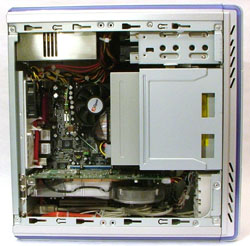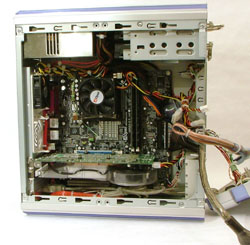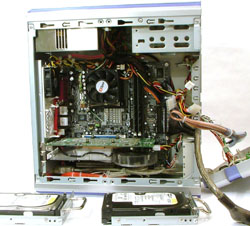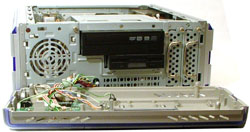System Review – PC-Club Silencer
by Jarred Walton on March 28, 2005 12:05 AM EST- Posted in
- Systems
Construction and Setup
The overall external build quality is generally good. Long-term durability should present no problem, although the case did have/develop a few scratches. It arrived at our location with some areas on the sides where the silver paint had worn off as well as a small ding. We're not sure if these happened during construction, with a previous reviewer, or perhaps due to our own negligence in handling the case, but we mention them nonetheless. As with most computer equipment, we would advise some care in handling the system. Hopefully, such blemishes are not coming from PC-Club, and we'll give them the benefit of the doubt. As we move to the internals, remember that our comments here will only affect you should you choose to try and upgrade the system, so we're not terribly concerned with the flaws in the internal design.   |
| Click images to enlarge. |
Once we open up the case, we encounter some good design aspects as well as some potential problems. On the good side of things, we have thumbscrews used for several items. Two secure the cover, and there are two more each for the optical/floppy bay, and each hard drive cage. The use of drive cages is also convenient, as it becomes easier to mount the HDDs without worrying about cables or other items getting in the way. The only complaint we had was that getting the cables connected to the rear of the drives was a little tricky in the cramped confines of the case. A little more slack on the SATA power and data cables would have helped, but that might also get in the way of airflow once the drives are secured in place.
 |
 |
| Click images to enlarge. | |
All is not well with the HDD setup, however. It's no secret that heat helps to kill hard drives. Last summer, in 100 F weather and a house without AC, I had a six-month-old Samsung HDD fail on me. It was placed in an Antec case with two other drives, and even the presence of a fan in front of the drives wasn't enough to keep them cool. We generally like to have at least a centimeter of open space above and beneath our hard drives, and a low RPM fan in front of the drives helps. The case does not have a fan at this location, although the power supply should provide for some circulation. As for proximity, with both hard drive bays filled, there is very little room for air circulation. We didn't have any issues during testing, but we were only using the system for a few weeks as opposed to months, so problems aren't likely to occur. Long-term - particularly in areas that get hot during the summer months - we are very concerned with the use of a 10,000 RPM Raptor in such a cramped space. Should you choose to purchase such a system from PC-Club, our advice would be to stick with two 7200 RPM drives at most, preferably models with fluid dynamic bearings. They're quieter and run cooler, which seems to be the better fit for such a system.
In a similar vein to the HDD heat concerns, the location of the RAM is right underneath the optical drive - completely obscured by the drive, in fact. Air flow to this area will not be very good; although with the maximum of two DIMMs, things should be okay. The inclusion of CL2.5 Mushkin RAM may be intended to lower heat output, and even with a 3:5 memory ratio, the RAM will be run at PC2700 speeds and overclocking won't get the RAM up to more than PC3200 speeds. We would be more concerned if there were four DIMMs and faster memory could be used, but in this design, the relatively confined quarters for the RAM shouldn't matter too much.
There are some other issues near the RAM, however. The floppy and IDE cables in the area create more "clutter", and while rounded cables help somewhat, they're on the long side. We would prefer the use of some shorter IDE cables instead. There is no room for a second IDE device near the DVD+RW, so a short, flat IDE cable would tuck away quite nicely, and the same goes for the floppy cable. Shuttle and several other SFF manufacturers have such cables, and even though PC-Club may not manufacture most of their components, procuring different cables should be simple to do. (The unit arrived with the floppy cable detached, incidentally - it appears to have come loose during shipping, likely due to the length and weight. Perhaps shorter cables would have avoided this problem.) One of the advantages of a pre-built system is that the system integrator should be able to tailor the build to the specific needs, and we don't think that PC-Club did as well as they could have in this instance.
Another minor concern with the construction is that the removal of the optical and floppy drive cage is a little... ungraceful. It works okay, but it could be better. The problem stems from the fact that you have to remove the front panel of the case, which is secured by plastic tabs. Once we figured out how to remove the front panel (the top-left plastic hook actually needs to be depressed from inside the case, whereas the other three corners simply pull out with a bit of force), we could work with the internals. However, the front panel has quite a few wires connected to it, so you end up with them hanging around as you install the hard drives and other parts. The internal structure of the case - specifically the CD/floppy cage - also feels a bit flimsy, particularly when the screws are not in place. It doesn't seem to be a problem when everything is connected and the cover is on, but long-term durability might not be the greatest. If you were to upgrade components regularly, the cage mechanism and front panel would be pretty irritating, as they cover the RAM. We noticed this as we ran several different configurations inside the case. We feel that this will only be a concern for users who purchase such a system and then decide to upgrade it themselves. Realistically, the only likely upgrade for such people would be a second HDD installed at a later date.
The final point that we would like to make on the construction has to do with the fans. We are not advocates of smaller fan sizes; quite the opposite, in fact. Obviously, you can't always fit a 120mm or even 80mm fan in every chassis, but the Athenatech case included one 40mm fan in the rear with space for a second fan to be added. The 40mm fan was spliced into the same power source as the CPU fan, allowing both fans to run off of one source. While the CPU fan was a 60mm model that spun at a low RPM and was nearly silent, the same cannot be said of the 40mm fan. It was by far the largest noise source in the system. After consulting with PC-Club, we unplugged the fan and were much happier with the result. Perhaps a different fan would generate less noise, and PC-Club says that the fan is not necessary, especially if you go with a single hard drive configuration. That would be our advice as well. For those who want to go to the other extreme, you could add a second 40mm fan in the rear as well as an 80mm fan on the front panel behind the LCD. We're not sure why you would want to do that, but the case does allow for it.
Overall, then, the construction of the case has a few minor problems. If PC-Club were designing their own cases, power supplies, and motherboards, we would suggest some alterations to the design. However, as they are simply a system builder, there's not much that they can do other than select different components. If you were to remove the optical drive and hard drives frequently, it would be very annoying. For the intended customers, it's not really a problem. Most users aren't going to open a system such as this and play with all the internals the way that we at AnandTech tend to do, and with PC-Club doing the system setup, you should be fine. We just wouldn't want to be the ones on the PC-Club assembly line, although we'd probably say that about any assembly line job.











22 Comments
View All Comments
yacoub - Sunday, May 29, 2005 - link
"If you lack such amenities and live in an area where indoor temperatures can break 90 C,"90 degrees Celcius?! LOL!! :D
JarredWalton - Friday, August 26, 2005 - link
Oops... fixed.finbarqs - Friday, April 1, 2005 - link
I stand neutral on this situation. Perosonally, I'm not into small computers, but i think that the Pentium M is an incredible platform, offering insane performance for such low clock speeds. (Instructions per clock?) but anyway, expensive to say the least... But it WAS a good idea to offer the Pentium M to the mass market....JarredWalton - Wednesday, March 30, 2005 - link
PC-Club asked us to review their Silencer. Find me another Pre-built Pentium M system from anyone on the market - I'm not aware of any. If HP, Dell, Micron... whoever asks us to review a system, we'll do our best to accommodate them. Besides, PC-Club is not exactly small - there are over 50 retail outlets scattered across the US, although the majority are in CA.michael2k - Wednesday, March 30, 2005 - link
#17: Statistically speaking, most people are average, so "the 75% of the hard core" would probably be more like the "10% of the readership".So this box is targeted towards the "30% average" who can't build a better box. My numbers are made up of course, but it's true that statistically the average probably can't build a decent PC.
Besides which, if I wanted a PC for 25% of the cost, 60% of the performance, and even quieter, I would buy a Mac mini, and Anand has very thoughtfully reviewed one for us.
deathwalker - Wednesday, March 30, 2005 - link
#16...its a good thing our federal government doesn't ever violate us!!....PC club? Lord where will we go next when we get desperate. I imagine the 75% of the hard core Anantech followers could do as good or better. How is it these jokers get space on this valuable tech. info website? I suppose next time i throw a box together I will write my name on it in crayon and send it in for a review.ElFenix - Tuesday, March 29, 2005 - link
technically, you're supposed to remit sales tax to your local taxing authority on mail order purchases. when i worked at dell they pounded into us that you cannot tell people they save money because they don't have to pay sales tax. doing so is a violation of federal law.Zepper - Monday, March 28, 2005 - link
Yes, PC club should have wired the case's LCD into the +5VSB circuit and/or provided battery backup for it. Any tech that can find his butt with both hands should have been able to figure that one out. But I still like the Athenatech A100 series - hard to beat for the price.. But when I'm building something that will total that much perhaps a Chenbro or Enermax Venus caae would have been a better choice.
.bh.
JarredWalton - Monday, March 28, 2005 - link
Just in case this isn't clear (#12), I *DO* like the system. The problem is that when a system is close to getting everything right, it just makes the areas where it falls short more noticeable. If I were actually buying the system, I'd go with the CoolerMaster case and two Seagate/Samsung HDDs. Also, $100 for assembly is generally less than I charge people. For a full PC setup with OS and software, I typically charge $150 unless it's a close friend/family member.#9 - Yes, you can build something reasonably silent on your own. I sort of take that as a given. Although I think you'll often pay more in the end, people that like to build their own PCs aren't really the target market for this system.
#10 - The point on taxes was that depending on location, it can add a lot. If you buy online from a site that doesn't have a retail presence in your state, you don't get hit with taxes. (I.e. Newegg is in CA and NJ, so if you live elsewhere you don't get taxes added in.) Now granted, you're *supposed* to pay taxes on these items anyway, but I don't know anyone that does. :p
#11 - I absolutely stick with my assessment of the Fuji S5000. Of course, the graininess is really a big problem when you're doing closeups. For pictures of people and such, you won't notice it much. Tweaking the colors and such also tends to make the graininess show up more, but it's necessary at times. It's not a *terrible* camera, but there are better alternatives in the price range.
#13 - The PSU is standard. My comment on the "usually a 200W" is related to the case purchased separately, i.e. at Newegg. The comments on the speakers and sound I agree with. I don't think an Audigy 2 ZS is necessary for most people, and it is an option at PC-Club (for $100 - retail version).
*Whew!* I think that covers everything. Again, I think PC-Club did a good job with this system, but there are still flaws and I feel it's my job as a reviewer to point them out. I hope that my article convinces them to offer an Athlon 64 flavor in the near future, as I think that would be a better alternative for gaming.
blckgrffn - Monday, March 28, 2005 - link
I would be pretty pissed if I got this computer, too. The components seem to be mismatched... having owned a Falcon-Northwest, I can attest to the fact that people who don't buy a dell or an emachine are going to be very picky about the system that they paid a good premium for. Any system from any OEM that wants to be considered elite needs to be well thought out and well implemented. I remember looking inside my Falcon and just saying wow about the cable management, the fans were quiet but pushed a good amount of air, and all of the components were at home with each other - unlike having a Raptor and a crazy loud fan in a SFF PC. That is just dumb and makes you wonder what they were thinking. Also, there was an allusion to a Power Supply upgrade just for Anandtech - a video card like that pretty much crys out for a 250watt+ QUALITY powersupply, not just a generic 200 watt one.I admit the price looks good for this system considering the components, but do not forget that it is supposed to be a gaming box - why wasn't there at least a Audigy 2zs thrown in for good measure? Ridiculous, as well as the speaker choice for a $2,000 system. I think that the FragBox from Falcon-NW is a very good SFF PC alternative, or if you don't care about size grab a good deal on an XPS.
This article was a nice bit of fresh air, it seems that too many reviews (not here, really, but in general) seem to overlook flaws rather than point them out. If I wanted to hear about how great a product was, I would read their marketing BS.
Thanks you Mr. Walton for an honest review.